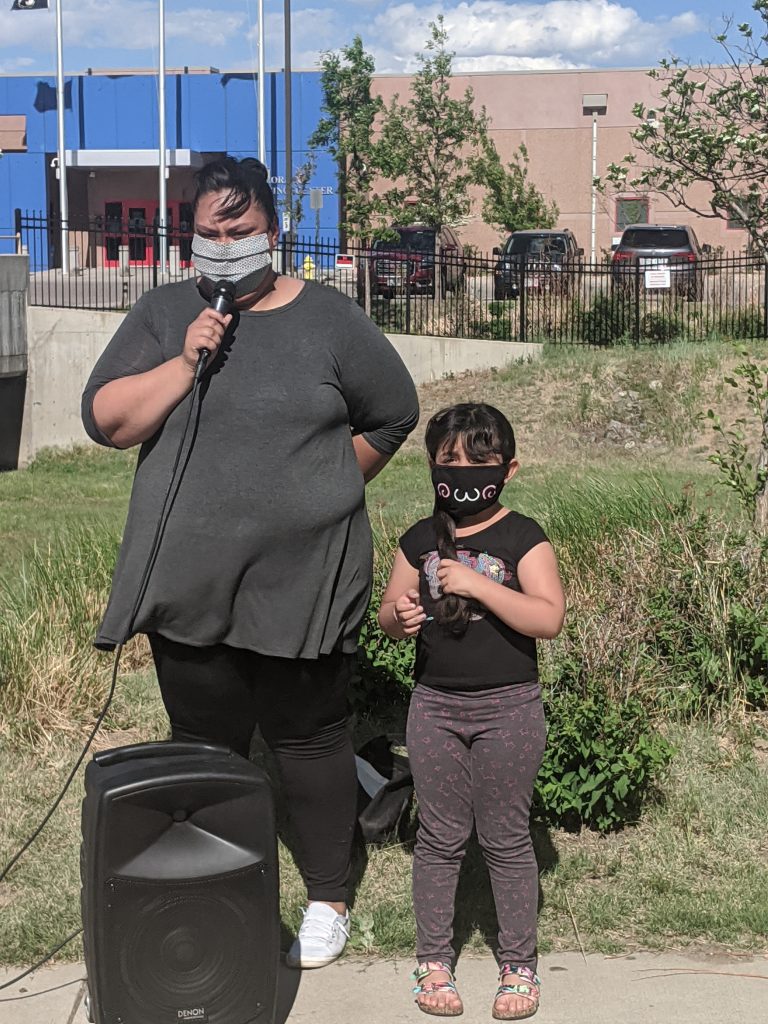In response to news that two immigrants were diagnosed with COVID-19 while in custody at an Immigration and Customs Enforcement (ICE) detention center in Aurora, several dozen activists rallied Friday in front of the facility, pushing for the release of detainees and an overhaul of the immigration system altogether.

“There’s probably a lot of cases, so it’s time to put the pressure on as much as possible,” said Ruby Tedeschi, who works for the non-profit Network in Solidarity with the People of Guatemala. “We know that COVID spreads rapidly through any kind of incarceration center or open-air prison.”
She advocated for the immediate “release of all detainees in this center,” both “in general and given the current circumstances.”
That’s unlikely to happen, though.
“ICE fully respects the Constitutional rights of all people to peacefully and lawfully express their opinions,” said Alethea Smock, a public affairs officer for ICE. “However, the agency will continue to perform its immigration enforcement mission consistent with federal law and agency policy,” she said, including “maintaining the safety and security of its employees and facilities.
Activists Fight Back
Ana Rodriguez, a community organizer with the Colorado People’s Alliance, a local social justice group, was holding a big blue sign on behalf of an activist who couldn’t make it.
“She’s actually a medical worker in Leadville, and that’s why she can’t be here today,” Rodriguez said of Claudia Robles, whose asthmatic husband is interned at the Aurora facility, according to Rodriguez.
“As more people get sick in this facility, more and more of their resources will be going to emergency care,” Rodriguez said. “There will be less opportunity for them to provide basic care to everyone else.”
Rodriguez alleged that Robles’ husband is already being denied access to his prescription medication.
“Anyone that goes in there with a pre-existing condition and a pre-existing need for medications has the hardest time actually getting that medication,” she said.
“Most of the time, they never get it while they’re… here at the center,” Rodriguez said. “They have to be deported.”
She said the man, who is “at high risk already,” has had trouble breathing lately.
“Given that wheezing is a symptom of COVID,” Rodriguez said Robles was “really concerned that they haven’t done a thorough examination of him, they haven’t checked his lungs and they haven’t checked him for COVID.”
Precautions?
“Detainees are being tested for COVID-19 in line with CDC guidance,” Smock said. “In some cases, medical staff at ICE detention facilities are collecting specimens from ICE detainees for processing at a commercial or public health lab.”
She said ICE has also “instituted screening guidance” for new detainees “to identify those who meet CDC’s criteria for epidemiologic risk of exposure to COVID-19.” Those who meet that criteria are monitored for two weeks regardless of whether they present with COVID-like symptoms.
Still, it was “very concerning” to Rodriguez “that people might present with COVID symptoms and they don’t test right away.”
She said according to contacts inside the facility, physical distancing has been enacted unevenly, if at all.
“We’re seeing that if there’s a four-person to a cell limit, they have three people per that cell,” Rodriguez said. “At first… they put them in 23 hour-a-day lockdown and rotated who was out in the common areas, but they had them in such small rooms that it was literally impossible for them to socially distance.”
Smock said ICE “convened a working group between medical professionals, disease control specialists, detention experts and field operators to identify additional enhanced steps to minimize the spread of the virus.”
The group decided “to reduce the population of all detention facilities to 70% or less,” and “to increase social distancing… by having staggered meals and recreation times in order to limit the number of detainees gathered together.”
Supplies
Rodriguez described supplies essential to the battle against COVID as in short supply in the facility.
“Sometimes they have masks. Other times, they don’t get any new ones so they have to keep re-wearing them,” Rodriguez said.
Smock said needed gear is being provided.
“The agency will continue providing appropriate personal protective equipment to individuals in ICE custody… in accordance with CDC guidance,” Smock said.
“They also don’t have consistent access to soap,” Rodriguez said, and sometimes “run out of disinfectants. I heard today that it looks like they finally have some stronger disinfectants, but again, this is nothing that’s constant.”
Deportations Continue
Through everything, ICE has still managed to follow through with its ultimate goal.
“Every Tuesday, people still get deported,” Rodriguez claimed. “The really concerning thing is that we’re seeing a lot of people being deported without ever having been tested for COVID.”
Rodriguez alleges “that there’s rampant cases of COVID in different detention centers” nationwide.
“People are being deported under the third safe country agreement, or the asylum co-operative agreement that the United States has with Guatemala,” Tedeschi said.
But the recent COVID infections were not the sole focus of the event. The strain on the families of those incarcerated predates the crisis.
Tears Fall
Kesha Davalos’ husband has been incarcerated at the Aurora facility since January. He hasn’t seen his outgoing, gymnastics-loving grade school-aged daughter named Saira Leah Grijalva since.

“He fell twice while cleaning the floors and he hit himself in the toe bone,” Davalos said. “He’s injured… [and] they still haven’t given him any medical treatment. They just want to give him ibuprofen.”
Things are not going much better for Davalos and the couple’s daughter on the outside.
“She has to go to therapy, as well as myself,” Davalos said.
When Davalos told her story to the crowd gathered in front of the facility, she did so through tears.
Being separated was hard for the sometimes peppy Saira, who was bawling in the back of a sedan after her mother spoke.



